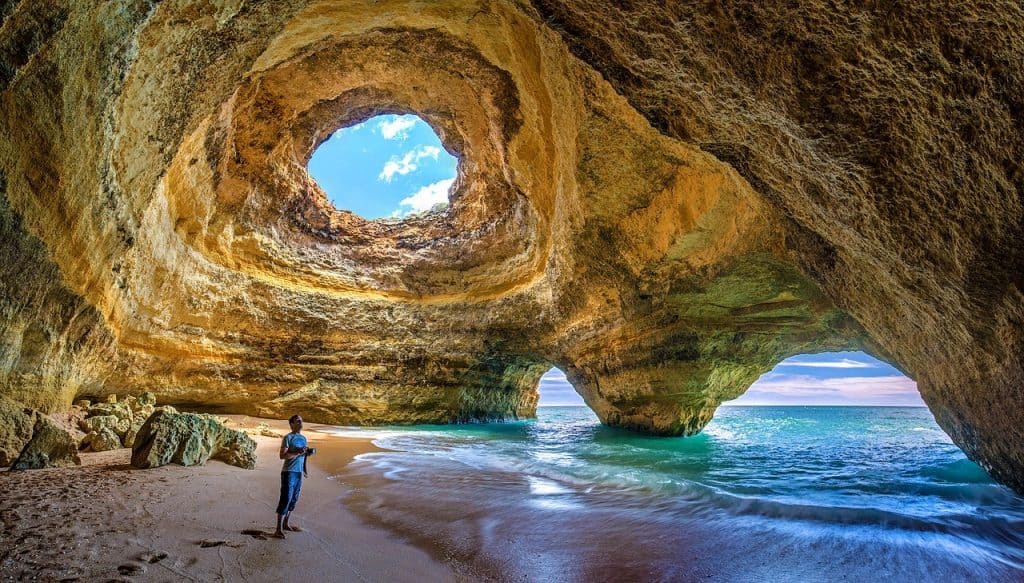The Benagil cave is a stunning natural wonder located on the Algarve coast of Portugal. This cave is known for its unique rock formations, crystal-clear waters, and sandy beaches. The Benagil cave is one of the most popular tourist attractions in the region, drawing visitors from all over the world to marvel at its beauty.
To reach the Benagil cave, visitors can take a boat tour or hire a kayak. As they approach the cave, they will be mesmerized by the sheer size of the cave’s opening. The entrance to the cave is a gaping hole in the side of a towering cliff, and the sun’s rays illuminate the cave’s interior, making it seem like a magical place.
Once inside the cave, visitors will be greeted by a vast, circular chamber. The walls of the cave are smooth and polished, and the turquoise water sparkles in the sunlight. As visitors look up, they will see a small opening in the ceiling of the cave, which allows a beam of sunlight to enter the cave, creating an otherworldly glow.
The Benagil cave is known for its natural architecture. The walls of the cave are adorned with a variety of rock formations, including stalactites and stalagmites. The cave’s dome-like structure is created by the erosion of the rock by the sea, forming a circular opening. The rock formations within the cave are awe-inspiring, and visitors can spend hours marveling at the intricate patterns and designs etched into the cave’s walls.

Visitors to the Benagil cave can also enjoy swimming and sunbathing on the sandy beach within the cave. The beach is accessible through a small tunnel that connects the cave’s interior with the outside world. The tunnel can only be accessed during low tide, making it a unique experience for visitors.
The Benagil cave is a natural wonder that has been sculpted by the sea over thousands of years. Its beauty is a testament to the power and wonder of nature. Visitors to the cave should take care to preserve its delicate ecosystem and leave no trace of their visit.
The Benagil cave is not just a natural wonder, but also a cultural and historical site. The cave has been a part of the Algarve’s coastal landscape for centuries, and its significance can be traced back to the region’s maritime history.
The Benagil cave was once a hideout for smugglers, who used the cave’s hidden beach and underground tunnels to avoid detection from authorities. The cave was also used as a storage area for goods, and as a shelter for fishermen caught in stormy weather.
Today, the Benagil cave is protected by the Portuguese government and is a designated conservation area. Visitors are encouraged to explore the cave’s beauty while also respecting its natural environment. The local authorities have implemented strict rules and regulations to preserve the cave’s ecosystem, including limiting the number of boats allowed to enter the cave and prohibiting visitors from touching or removing any of the cave’s natural features.

The Benagil cave is not the only attraction in the area. The Algarve coast is home to a plethora of other caves, cliffs, and beaches that are equally impressive. Visitors can take a boat tour to explore the various caves and cliffs, or hike along the coast to take in the breathtaking views.
In addition to its natural beauty, the Algarve region is known for its rich history and culture. The region was once occupied by the Moors, who left their mark on the architecture and cuisine of the area. Visitors can explore the region’s history by visiting historic sites such as castles, churches, and museums.
The Algarve region is also famous for its seafood, which is caught fresh daily from the Atlantic Ocean. Visitors can sample a variety of dishes, including grilled sardines, octopus salad, and seafood stew.
In conclusion, the Benagil cave is a natural wonder that is steeped in history and culture. Its beauty is a testament to the power of nature, and its significance can be traced back to the region’s maritime past. Visitors to the cave and the Algarve region will be treated to a unique and unforgettable experience that combines natural beauty, cultural richness, and culinary delights.
If you enjoyed this read, check out our other posts.














What do you think?
Show comments / Leave a comment